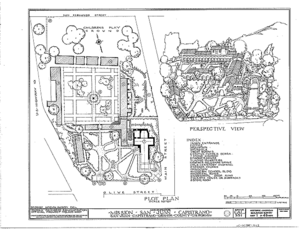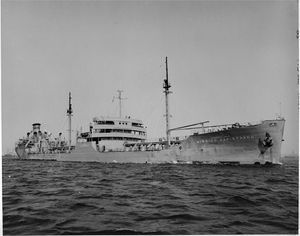Mission San Juan Capistrano/Gallery
(PD) Diagram: U.S. Land Surveyor's Office
The "Alemany Plat" prepared by the U.S. Land Surveyor's Office to define the property restored to the Catholic Church by the Public Land Commission, later confirmed by presidential proclamation on March 18, 1865.[1](PD) Image: Abraham Lincoln
President Abraham Lincoln's signature as it appeared on the United States Patent that restored the Mission property to the Catholic Church in 1865. This is one of the few documents that the President signed as "A. Lincoln" instead of his customary "Abraham Lincoln." [2](PD) Painting: Fred Behre / John Gutzon Borglum
An 1894 painting by Frederick Behre features a wildly-improbable steeple over the entrance of San Juan Capistrano's "Great Stone Church" (it was incorrectly believed to portray the way the church looked before the 1812 earthquake; archaeological excavations in 1938 revealed that the steeple placement as shown in the painting was impossible).[3] The landscape in the background of this painting was later modified by John Gutzon Borglum.[4] Watercolor and gouache.(PD) Photo: The University of California Archives
The partially-restored plaza at Mission San Juan Capistrano as it appeared circa 1896. To the right is the sala, which served as the Mission chapel from 1891 until Serra's chapel was restored in the mid-1920s; the building also housed the Forster family during their time at the Mission.[5] Just left of center is Father Mut's former residence, including the loft he had constructed.[6]
(PD) Photo: William Henry JacksonOne of the earliest examples of "Mission Revival Style" architecture, the Atchison, Topeka and Santa Fe Railway depot in San Juan Capistrano (with its 40-foot [12-meter] high dome and bell) was considered to be one of the railroad's finest when it was completed on October 8, 1894; it officially entered service on October 27 of that year.[7] The San Juan Capistrano station has remained in use and today is served by Amtrak, the national railroad passenger system, and Metrolink, a commuter railroad.
(PD) Photo: San Juan Capistrano Historical Society
Mary Astor and Gilbert Roland starred in George Fitzmaurice's 1927 motion picture Rose of the Golden West, shot on location on the Mission grounds.[8] The film's penultimate scene (shown here) is set amidst the ruins of "The Great Stone Church."
(CC) Photo: Robert A. Estremo
This 2nd-story refectory and bell tower was constructed atop the former carpentry shop on the north wing of the Mission's quadrangle in 1936.[9]
(PD) Photo: United States Navy / David Buell
USNS Mission Capistrano (T-AO-112) steams out of the Port of Long Beach, date unknown.
Notes
- ↑ Engelhardt 1922, p. 167: The document was recorded on December 15, 1875 by the County Recorder of Los Angeles at the request of the Right Reverend Bishop T. Amat.
- ↑ Engelhardt 1922, p. 169
- ↑ Stern and Miller, p. 92
- ↑ Stern and Miller, p. 95
- ↑ Hallan-Gibson, p. 42
- ↑ The loft space was used for storage of the Mission baptismal, confirmation, marriage, and death records after Father Mut's departure.
- ↑ Gustafson and Serpico, p. 192: Much of the stone, bricks, and roof tiles were gathered from the decaying Mission, preservations efforts having not yet begun at the time of the station's construction.
- ↑ Hallan-Gibson, p. 73
- ↑ Leffingwell, pp. 36-37
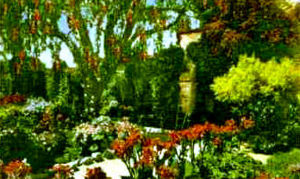
![(PD) Diagram: U.S. Land Surveyor's Office The "Alemany Plat" prepared by the U.S. Land Surveyor's Office to define the property restored to the Catholic Church by the Public Land Commission, later confirmed by presidential proclamation on March 18, 1865.[1]](/wiki/images/thumb/a/ad/SJC_restored_property.jpg/213px-SJC_restored_property.jpg)
![(PD) Image: Abraham Lincoln President Abraham Lincoln's signature as it appeared on the United States Patent that restored the Mission property to the Catholic Church in 1865. This is one of the few documents that the President signed as "A. Lincoln" instead of his customary "Abraham Lincoln." [2]](/wiki/images/thumb/4/44/A_Lincoln.png/300px-A_Lincoln.png)
![(PD) Painting: Fred Behre / John Gutzon Borglum An 1894 painting by Frederick Behre features a wildly-improbable steeple over the entrance of San Juan Capistrano's "Great Stone Church" (it was incorrectly believed to portray the way the church looked before the 1812 earthquake; archaeological excavations in 1938 revealed that the steeple placement as shown in the painting was impossible).[3] The landscape in the background of this painting was later modified by John Gutzon Borglum.[4] Watercolor and gouache.](/wiki/images/thumb/9/9e/MSJC_by_John_Gutzon-Borglum.jpg/300px-MSJC_by_John_Gutzon-Borglum.jpg)
![(PD) Photo: The University of California Archives The partially-restored plaza at Mission San Juan Capistrano as it appeared circa 1896. To the right is the sala, which served as the Mission chapel from 1891 until Serra's chapel was restored in the mid-1920s; the building also housed the Forster family during their time at the Mission.[5] Just left of center is Father Mut's former residence, including the loft he had constructed.[6]](/wiki/images/thumb/4/43/SJC_plaza_circa_1896.jpg/300px-SJC_plaza_circa_1896.jpg)
![(PD) Photo: William Henry JacksonOne of the earliest examples of "Mission Revival Style" architecture, the Atchison, Topeka and Santa Fe Railway depot in San Juan Capistrano (with its 40-foot [12-meter] high dome and bell) was considered to be one of the railroad's finest when it was completed on October 8, 1894; it officially entered service on October 27 of that year.[7] The San Juan Capistrano station has remained in use and today is served by Amtrak, the national railroad passenger system, and Metrolink, a commuter railroad.](/wiki/images/thumb/1/16/CHS_J3074.jpg/300px-CHS_J3074.jpg)
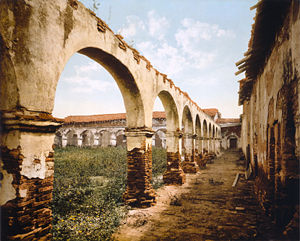
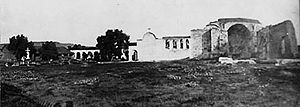
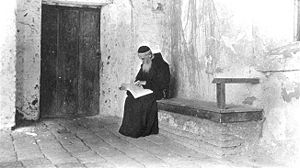
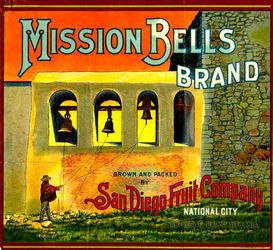
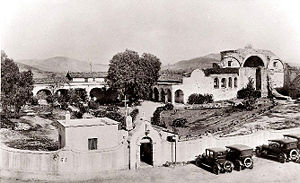
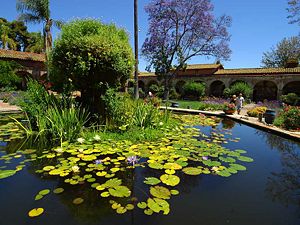
![(PD) Photo: San Juan Capistrano Historical Society Mary Astor and Gilbert Roland starred in George Fitzmaurice's 1927 motion picture Rose of the Golden West, shot on location on the Mission grounds.[8] The film's penultimate scene (shown here) is set amidst the ruins of "The Great Stone Church."](/wiki/images/thumb/8/8b/Rose_of_the_Golden_West.jpg/300px-Rose_of_the_Golden_West.jpg)
![(CC) Photo: Robert A. Estremo This 2nd-story refectory and bell tower was constructed atop the former carpentry shop on the north wing of the Mission's quadrangle in 1936.[9]](/wiki/images/thumb/2/2d/Mission_SJC_Refectory.jpg/300px-Mission_SJC_Refectory.jpg)
